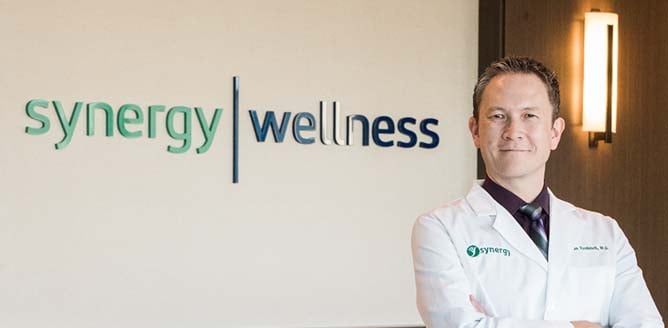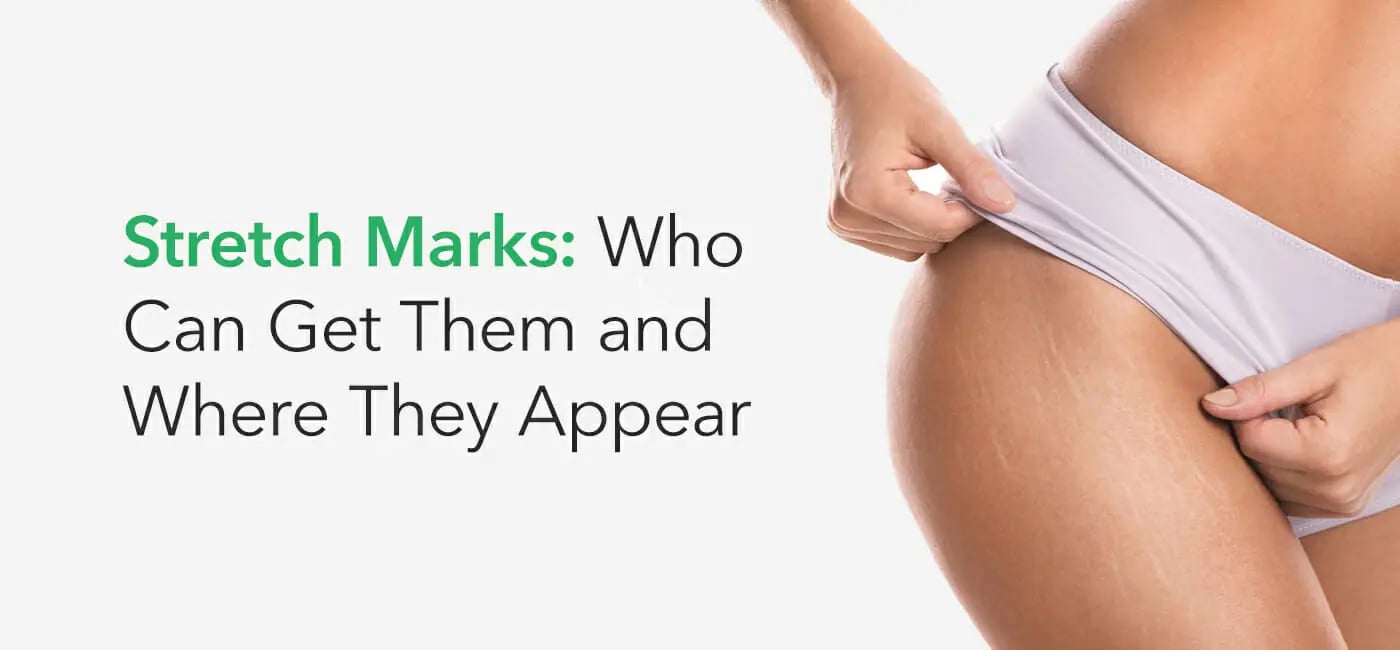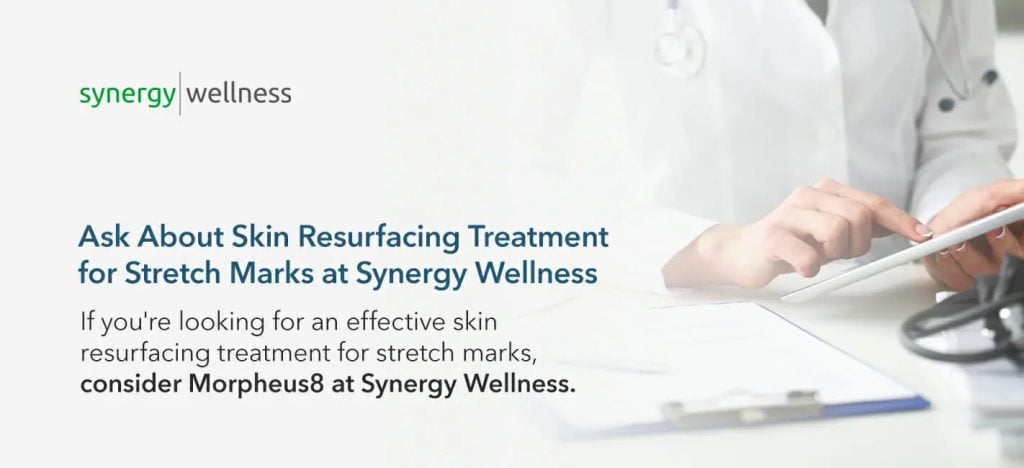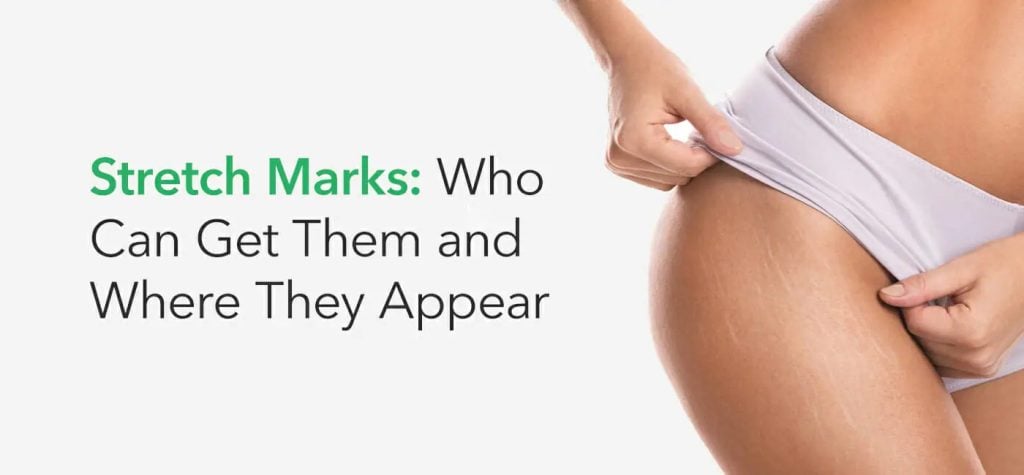
While most people associate stretch marks with puberty or pregnancy, many people — especially some athletes like bodybuilders — notice stretch marks on their arms. Stretch marks around the biceps and shoulders are not uncommon. If red or white stretch marks on your arms are a cosmetic concern for you, there are various methods to remove stretch marks available to you.
To help you understand your stretch mark removal options, this article will go over what stretch marks are, what factors can cause them, how to reduce new stretch marks’ appearance and the best long-lasting options for treating stretch marks. Keep reading to find out how you might be able to get rid of the red or white stretch marks on your arms.
Contact Us for Skin Resurfacing Treatment
What Are Stretch Marks?
Essentially, stretch marks are scars due to your skin getting stretched farther than it is used to within a short amount of time. When skin gets stretched too far and too quickly, its elastic fibers can tear. This tearing takes place in the dermis, which is your skin’s middle layer. As those damaged lines of elastic fibers in the dermis heal, they form long, thin scars known as striae — more commonly referred to as stretch marks.
While stretch marks are a common condition, they can show up differently for various people. This section will discuss who can get stretch marks, where they can get them and how the marks manifest further.
Where Can You Get Stretch Marks?
Stretch marks can appear on many different parts of the body. Some of the most common places people notice stretch marks include:
- Abdomen
- Arms
- Back
- Breasts
- Buttocks
- Hips
- Shoulders
- Thighs
Who Can Get Stretch Marks?
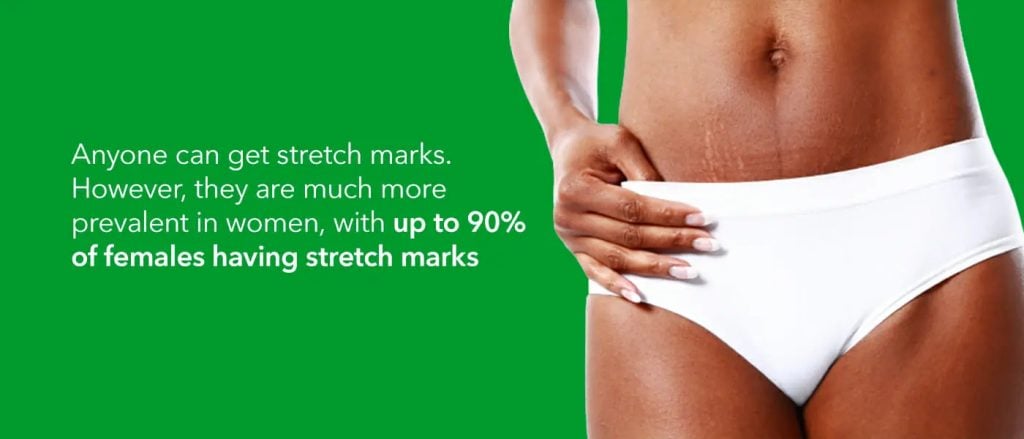
Anyone can get stretch marks. However, they are much more prevalent in women, with up to 90% of females having stretch marks somewhere on their bodies. Most commonly, teenaged girls get stretch marks around their breasts, hips or thighs, and boys get them near their lower backs or hips due to growth spurts during puberty.
What Are the Symptoms of Stretch Marks?
Not all stretch marks look the same. Depending on what caused the stretch marks, where they are on your body and how long you’ve had them, your stretch marks could have different characteristics. Most often, stretch marks appear in one of the following forms:
- Indented lines or streaks on the thighs or buttocks
- Pink, red, blue, purple or black streaks
- White stretch marks on arms
- Bright streaks that fade into a lighter color
- Streaks that cover a large area of the body
- Faded stretch marks from years ago
Though newer stretch marks may feel itchy and slightly raised, they will fade to lighter, thinner streaks over time. Typically, stretch marks first appear as a reddish or purple hue before turning silvery or white. Once stretch marks take on a white, scar-like appearance, they may become permanent, which is why it is essential to address stretch marks as soon as possible.
To diagnose stretch marks, a doctor merely has to look at them. Your doctor may also ask you about your medical history before making a definitive stretch marks diagnosis.
In general, stretch marks do not pose any physical danger, but they can lead to a negative self-image, anxiety and other mental health issues. In some cases, these cosmetic concerns have a significant emotional effect that can interfere with day-to-day living.
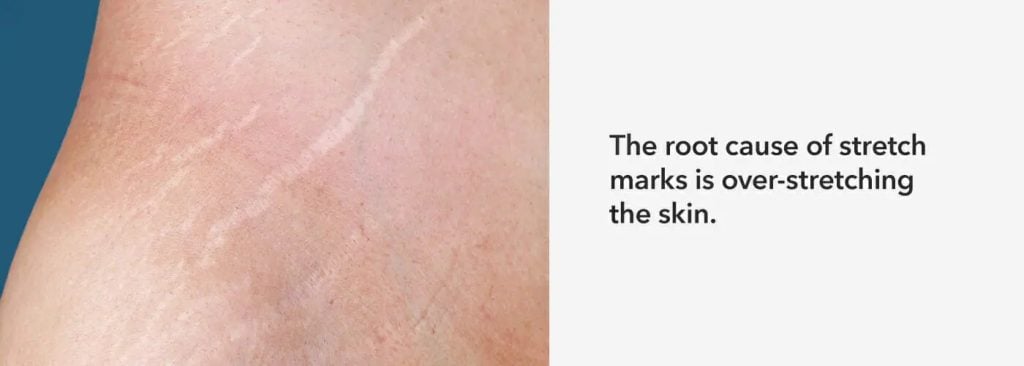
What Causes Stretch Marks to Appear?
The root cause of stretch marks is over-stretching the skin. Stretch marks occur within the skin’s middle layer when the connective tissue gets pulled beyond its realm of flexibility. This excessive stretching can also damage the skin’s collagen, an essential structural protein of the body’s connective tissue.
As the skin stretches, its collagen weakens and the regular collagen production that keeps the skin looking youthful gets disrupted. These events leave behind the discolored streaks known as stretch marks. The more stress that gets put on the skin and its collagen, the greater the likelihood that stretch marks will begin to show up.
Several variables can contribute to this stretching of the skin and affect the resulting stretch marks’ severity. Let’s look at some of the most typical reasons stretch marks occur.
Genetics and Medical Conditions
Genetics can play a role in whether you develop stretch marks because they tend to run in families. Some conditions can also affect stretch marks’ appearance, especially those that impact the adrenal glands. The following medical issues can lead to stretch marks.
- Cushing’s syndrome: This illness can cause the body to produce too much of a hormone that prompts rapid weight gain and skin fragility, which leads to stretch marks.
- Marfan syndrome: Marfan syndrome is a rare genetic condition that affects connective tissues and weakens the skin’s fibers to cause unusual growth, resulting in stretch marks.
- Ehlers-Danlos syndrome: Another genetic rarity, EDS is a group of conditions that occur from genetic changes to collagen, which can cause stretch marks.
Hormones
For those without Cushing’s syndrome, hormones can still play a role in creating stretch marks. In particular, cortisol is one hormone that may contribute to stretch marks and skin damage. The adrenal glands produce this hormone that can weaken the skin’s elastic fibers, resulting in increased stretch marks.
Puberty
Many kids experience extreme growth spurts during puberty. These periods of rapid growth can stretch their skin beyond its flexibility, resulting in stretch marks. Seeing stretch marks pop up during puberty is normal, and many childhood marks gradually fade.
Muscle Growth
Gaining muscle is another form of rapid growth that can lead to stretch marks. Bodybuilders are especially at risk of developing stretch marks because they tend to add muscle mass quickly, which can over-stretch the skin. Even those with very little fat can get stretch marks where their muscles bulge, such as on their arms near the biceps.
Weight Gain
Along with rapid growth, rapid weight gain can result in stretch marks. Gaining a lot of weight within a short time can strain the skin past its limits. The more weight gained, the more likely stretch marks are to occur.
Because quick and sudden body changes can lead to stretch marks, pregnancy is also a prevailing cause of this condition. Between stretching the skin and causing a surge in hormones that weaken skin fibers, pregnancy is one of the primary culprits of causing stretch marks for women. However, the stretch marks may start to fade as new moms lose weight after giving birth.
Medications
Some medications can cause side effects like weight gain, bloating, swelling and other bodily changes that stress the skin and result in stretch marks. Specifically, hormones like birth control pills and corticosteroids, which ease inflamed areas of the body, can increase your chances of getting stretch marks.
Corticosteroids are anti-inflammatory drugs most commonly used to treat rheumatologic conditions, such as rheumatoid arthritis or vasculitis — inflammation of the blood vessels. Prolonged use of corticosteroid lotions and creams can result in stretch marks because it decreases the skin’s natural collagen levels. This structural protein is vital for strengthening and supporting skin health, so a reduced amount of collagen can add to the risk of stretch marks.
Are Stretch Marks Dangerous?
In general, stretch marks are purely a cosmetic concern and pose no major health risks. However, stretch marks may be slightly painful at times due to the pulling of the skin. Stretch marks can come with a sharp pain in the affected area, like someone pinching your skin. Itchiness and soreness can also occur as the skin works to repair itself. Keeping your skin well-moisturized can prevent dryness and reduce your stretch marks’ itchiness.
The scar tissue that develops as the skin heals may also be thicker than healthy skin. This stiffness can make your skin feel uncomfortable and may result in a mild feeling of pain whenever your clothes rub against the tender stretch mark.
Along with these side effects of discomfort, stretch marks can remind some people of unwanted weight gain and make them self-conscious. In some cases, stretch marks can cause intense embarrassment and even feelings of depression. If you experience changes in your mood or self-confidence due to stretch marks, make sure you discuss those feelings with your doctor.
You should also see your doctor if stretch marks appear on your body, but you have not recently undergone physical changes like rapid muscle growth, weight gain, puberty or pregnancy. On rare occasions, unexplained stretch marks might indicate a more severe condition, such as Cushing’s syndrome.
Are Stretch Marks Preventable?
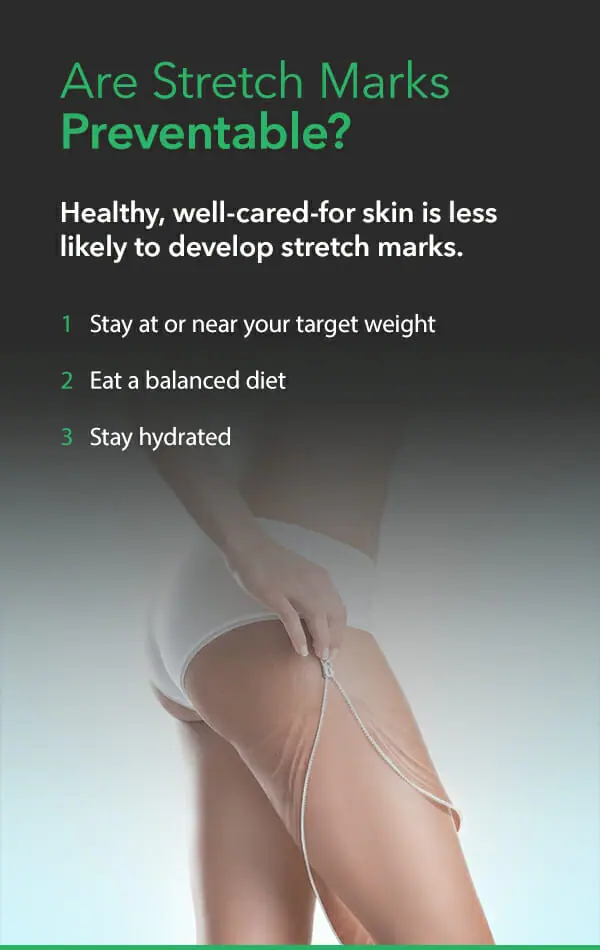
The best way to prevent stretch marks from forming in the first place is to stay at or near your target weight, stick to a balanced diet and stay hydrated. Doing so will boost your skin’s health and help keep it from becoming overly stretched or stressed. Healthy, well-cared-for skin is less likely to develop stretch marks.
To prevent stretch marks, eat more foods that provide ample vitamins and minerals. Specifically, make sure your daily meals include plenty of skin-loving nutrients, such as vitamin C, vitamin E, zinc and silicon. Make sure you drink enough water each day, which will help your skin remain supple, flexible and pliable.
If you begin to notice red or white stretch marks appearing on your arms or anywhere else, the best approach is to treat them as soon as possible to prevent them from becoming permanent. For many early cases of stretch marks, keeping the skin moisturized is an effective treatment method.
Massaging oils such as coconut oil, olive oil or almond oil into your skin can be a natural way of reducing stretch marks. The massaging motion will increase blood flow to the affected area, while the oil helps reduce the marks’ appearance. This technique is popular among those with stretch marks on their arms because it is an easy, natural task you can perform at home.
Along with specific oils, other topical creams and gels can help you manage your stretch marks. While you can find many stretch mark treatments at your local drugstore, very few have proven benefits. However, many people have experienced positive results after using topical stretch mark treatment.
Here are the most common stretch mark creams and gels.
- Tretinoin cream: The active ingredient in tretinoin cream is retinoid, a compound related to vitamin A. Retinoids boost collagen production and may help fade newer stretch marks.
- Trofolastin cream: This cream incorporates the extract of Centella Asiatica, a medicinal herb thought to increase collagen production.
- Alphastria cream: Alphastria cream also stimulates collagen production by mixing fatty acids and vitamins with hyaluronic acid, a natural lubricant.
- Silicone gel: Applying silicone gel can help lessen the itchiness that may come with stretch marks and increase collagen levels.
How to Treat Stretch Marks
To remove older stretch marks on the arms, at-home remedies and topical creams may not be enough. More intensive treatments for stretch marks, such as platelet-rich plasma injection procedures and microneedling, can help the body rebuild its collagen and elastin. Giving these proteins a boost speeds up the skin’s natural healing process and can reduce stretch marks’ appearance.
During platelet-rich plasma treatment, a provider will draw your blood, then spin it in a centrifuge to separate the plasma. This process promotes more growth factors, platelets and active proteins to assist with tissue and injury healing. Then, they’ll reintroduce the plasma into your skin through an injection or microneedling to stimulate a localized stem cell response. This stem cell response encourages collagen-producing cells to replace damaged tissue with healthy skin, minimizing stretch marks.
Even without platelet-rich plasma, microneedling benefits people with stretch marks on their arms because it is an effective and minimally invasive treatment. The technique uses tiny, fine needles to make microscopic punctures in the skin’s top layer. The mild wounds trigger the body’s natural response to generate more collagen and elastin to heal the skin, resulting in improved texture and reduced scars and stretch marks.
Along with restarting natural collagen production that stretch marks disrupted, microneedling stimulates the overproduction of collagen and elastin to heal damaged connective tissues. Using microneedles to penetrate the dermis helps restructure your deep tissue and smooth your skin from within. Healing these damaged tissues can correct stretch marks and increase your confidence.
Ask About Skin Resurfacing Treatment for Stretch Marks at Synergy Wellness
If you’re looking for an effective skin resurfacing treatment for stretch marks, consider Morpheus8 at Synergy Wellness. Morpheus8 is one of the most advanced restorative skin treatments available that pairs microneedling with fractionated radiofrequency to work deep within the dermis. The RF energy heats the skin’s deeper layer, stimulating the body to produce new elastin and collagen in that area.
Morpheus8 is a minimally invasive procedure that involves almost no risk, which means your treatment session could take as little as an hour or two. You may also see results as quickly as the next day, and continue enjoying improvements over the following months.
To find out more about your skin resurfacing treatment options or schedule an appointment, contact Synergy Wellness today.

